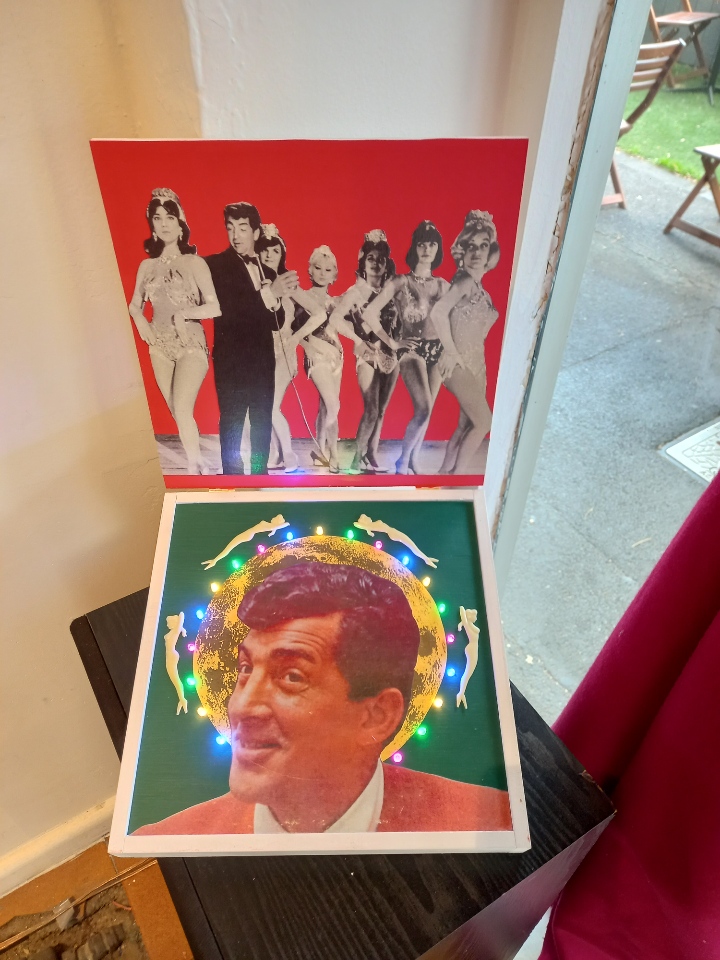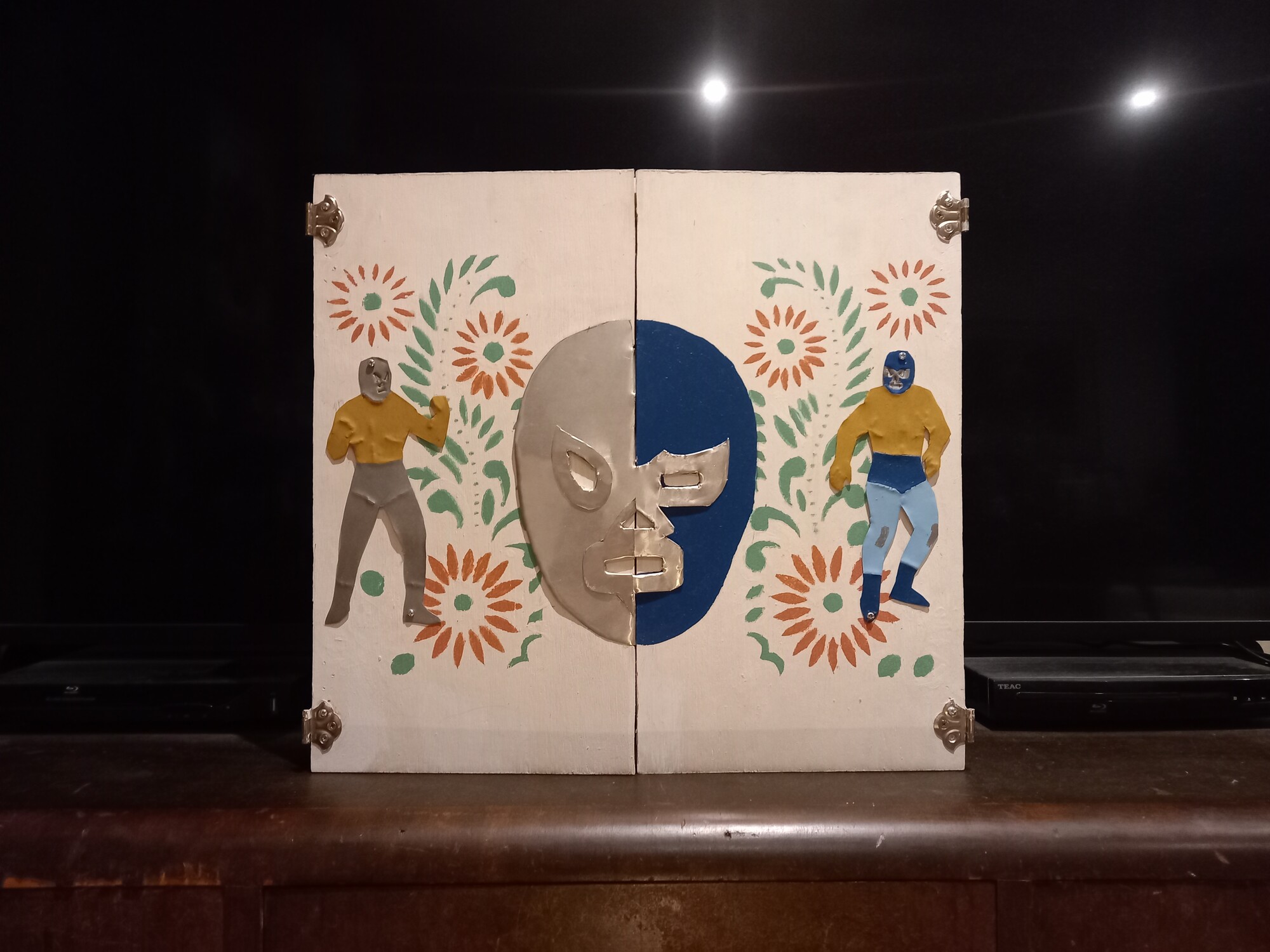Philippa Berry, Lawrence Tierney Shrine, open. Photo: Philip Brophy
Phillipa Berry’s “Shrine Show”
Philip Brophy
Why do I like movies and records more than paintings and sculptures? Because the former openly fabricate worlds while the latter only represent them. Movies and records are unto themselves; they are phantasmal stages and sonofied spaces, animated by bodies, beings, faces and voices. Paintings and sculptures—while fascinating in their erotic lean into artifice—trade in proxies; they plasticate reality and mould its forms. Stars of the silver screen and gold records make your world. Artists give you their world. Fans clamour the former realm like intoxicated acolytes; critics cruise the latter realm like neurotic aesthetes. This rickety, bitchy distinction won’t sway those who have committed their passion, practice or profession to the visual arts and its attendant art world. But it is the best way to start considering the unique world opened up by Phillipa Berry’s series of Shrines, which she describes as “a collection of offbeat altars dedicated to movie tough guys, mad scientists, gorillas, glamour girls, wrestlers, stuntmen, musicians, ecdysiasts.”

Installation view of Philippa Berry, Dean Martin Shrine, closed, at One Star Gallery. Photo: Philip Brophy

Installation view of Philippa Berry, Dean Martin Shrine, open, at One Star Gallery. Photo: Philip Brophy
Phillipa’s shrines (stars always use first names) are precisely what she says they are: votive reliquaries for demented yet serious idol worship. They are collectively dedicated to stars of bygone strata of the film and recording industries, all of whom became tragic and torn, forgotten and forlorn. Since 1991, she has been making them once a favourite figure has passed away. The “Shrine Show” at One Star Gallery presents around thirty shrines completed this year. Untameable left-field actors (Robert Mitchum, Warren Oates, Albert Dekker, Lawrence Tierney, Lee van Cleef, Bobby Driscoll, Gloria Grahame, Audie Murphy, Lionel Atwill, Barbara Payton, John Wayne, Jeffrey Hunter, Dennis Hopper, Hedy Lamarr). Roustabout stunt supremos (Steve Calvert, Evel Knievel). Independent exploitation filmmakers (Bert I. Gordon, Ray Dennis Steckler). Mexican lucha libre wrestling stars (El Santo, Blue Demon, Mil Mascaras, Wolf Ruvinski). Cult music icons (Hank Williams, Link Wray, Lee Hazelwood, all four of The Ramones). Buxom burlesque beauties (the 1953 Striporama film, starring Bettie Page and Storm Tempest among others). Phillipa’s preferences for this Hadean milieu of popular entertainment is astute and comprehensive. Seminal guides to the stylistics, sensibilities and aesthetics of this un-Pop nether region were fostered by Kenneth Anger’s Hollywood Babylon (1975), John Waters’s Shock Value (1981), Michael Weldon’s The Psychotronic Encyclopaedia of Film (1983) and Nick Tosches’s Unsung Heroes of Rock’n’Roll (1984). These works collectively ignored all and any taste-bound gatekeepers, not merely to champion badness but to luxuriate in the bounty of sensations offered by the underbelly of cinema and music which didn’t rebel against or critique normalcy so much as reject and confound it.
Most of Phillipa’s shrines feature a cabinet fronted by two doors which the viewer opens outward from a central axis. While the front facades are modest in design and decoration, the spread-eagle doors create a panorama twice the cabinet’s width, blending a central diorama of purposeful trinkets and bric-à-brac with side vertical panels (the rear side of the doors) emblazoned with posters, photos and press paraphernalia. Print-out paragraphs of the stars’ sensational and tragic biographies function as wall didactics. There’s something charged about the secrets held behind these doors, as if they are private dressing rooms of gloriously deviant figures who either hid their compulsions from the world (the perversions of Atwill, Dekker, Grahame) or immolated in public displays of immoral decay (the ‘rehaboholics’ of Hopper, Driscoll, Tierney). Phillipa both thrills to their private passions and public hysterics, and fondly embraces the wonderful Otherness of these people to whom normality and propriety were always anathema. Maybe I’m reading too much into them, but each shrine feels imbued with a delirious passion in the devotional sense. Phillipa loves this brethren of losers, users and self-abusers—all of whom attained an uncompromising greatness neither you nor I will ever attain. For some, the woebegone tales of these now-obscure figures will elicit a loud guffaw. For others, a silent tear will be inwardly shed. Best of all, the shrines don’t manipulate a viewer’s response through gratuitous humanist handwringing or passive-aggressive empathy tactics. In real life, the icons they sanctify didn’t demand anything from the world, and ultimately care little for what the world thought of their behaviour. If only more people behaved that way.

Philippa Berry, El Santo vs Blue Demon Shrine, closed. Photo: Philip Brophy

Philippa Berry, El Santo vs Blue Demon Shrine, open. Photo: Philip Brophy
The shrines elucidate what it means to be standing in front of something that functions as a portal to another world, transferring one to the departed’s lost space. I find them magical in the most material sense. They lead viewers to silently honour those flaming stars who once burned brightly, only to flame out and crash on the barren desert of a sneering society. And yes: such lurid poetics match the brash and sassy appeal of these frail constructions “crudely created using recycled wood from pallets and fancy wine packaging, and leftover paint samples,” as Phillipa notes. If this was a Guardian review, the most banal terms would orient an unsophisticated audience as to the shrines’ formal qualities and cultural positioning: kitsch, crass, lowbrow, trash, B-grade, tacky, pulp, corny, cheesy, amateur, even outsider. This is an audience that talks about “guilty pleasures” and things being “so bad they’re good.” God, when will those snooty pince-nez slurs ever die? If you use those terms in your culture-critic tool kit, all I can say is go to www.wheelercentre.com—and please stay there. Phillipa inhabits a different world—not one that is superior, radical, alternative or extreme, but one whose orbit is determined by wonderfully unreal dynamics. The gleaming sweat on El Santo’s curvaceous pectorals; the icy sneer of Albert Dekker’s death mask in lingerie; the rustic woody fuzz of Link Wray’s switchblade guitar; the bloodied mug of an inebriated Lawrence Tierney; the pneumatic chassis of Tempest Storm’s busty temple. Spiritual—kinda. Corporeal—hell, yes.
Philippa’s world is fuelled by intoxication and fascination (see the twelve issues to date of her xeroxed visual compendia of sexy movie icons, Glamour). With zero restraint and 100% respect, her shrines are presented as 1-800 direct lines to her pantheon of titans from psychotronic cinema and rock’n’roll, channelled through her psychic switchboard. No wires are ever crossed with the world of art, capitalized or otherwise. Which makes this review potentially smack of critically slumming by affording her personal testaments of dark glamour a critical depth they neither desire nor require. My forced road barriers between movies/records and paintings/sculptures are mere personal mental constructions: ineffective as arguments about art, but workable for the unique situation presented in Shrine Show. The act of opening each of their doors vividly frames them as portals to an unimaginable sublime, rather than potholes of predictability that are so commonplace with art that seeks to make connections with movies and music.
Philip Brophy writes on art among other things.


